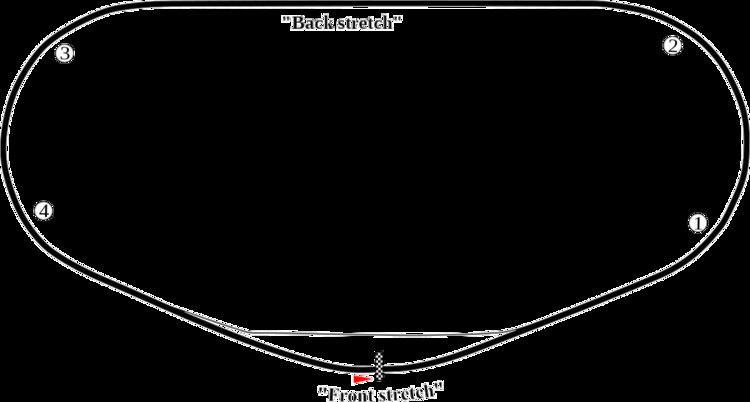Official name Daytona 500 by STP | ||
 | ||
Date February 17, 1991 (1991-02-17) Location Daytona International Speedway, Daytona Beach, Florida Course Permanent racing facility
2.5 mi (4.02336 km) Distance 200 laps, 500 mi (804.672 km) Weather Temperatures reaching as high as 63 °F (17 °C); wind speeds approaching 13 miles per hour (21 km/h) | ||
The 1991 Daytona 500, the 33rd running of the event, was held February 17 at Daytona International Speedway, in Daytona Beach, Florida. Davey Allison won the pole. In the first Gatorade 125 on Thursday, Richard Petty edged Hut Stricklin for second place, placing The King 3rd on the grid.
Contents
A notable absentee was 1972 Daytona 500 winner A. J. Foyt. Foyt was badly injured in the Texaco-Havoline 200 IndyCar race at Road America in the fall of 1990. He suffered severe injuries to his feet and legs, and spent several months out of a racecar before returning to action at Indianapolis in May 1991. Foyt missed his first Daytona 500 since 1965.
Pit rules
This race began a series of changes to pit road procedure after the death of a Melling Racing rear tire changer in a pit road accident at Atlanta the previous November.
The new pit procedures changed the complexity the race. Teams considered it too time consuming to change four tires since it had to be done under green (at the time, a four-tire pit stop would take roughly 20–25 seconds). For an example of how the rules adversely affected the racing, Kyle Petty ran the entire 500 miles on the same left side tires. Bill Elliott suffered a flat tire early on, and was forced to limp around the track at a reduced pace for two laps before he was allowed to pit, effectively eliminating him from competition.
By April, the rules were changed. At Bristol, the blue/orange procedure was used only for cautions – blue sticker cars pitting on the first lap under caution, orange sticker cars pitting on the second lap. On the restarts, blue sticker cars started on the inside and orange sticker cars on the outside. Lapped cars went to the rear. The blue/orange rule was eliminated during green flag stops. By the next week at North Wilkesboro, the blue/orange rule was scrapped. In its place, lead lap cars only were allowed to pit on the first caution, while lapped cars on the second lap.
After a few weeks, the rules were relaxed further, and eventually reverted nearly back to original regulations. The pit road speed limit, and use of the "lollipop" style sign board were the only significant changes made permanent. No longer was a second pace car used to pace the speed in the pits. Drivers would be required to gauge their own speed (by checking their RPMs) and officials enforced the infractions with a system similar to VASCAR. The rule closing pit road when the caution comes out also remained in place, as well as only permitting lead lap cars to pit on the first caution lap (lapped cars on the second).
The start
Davey Allison led the first lap from Dale Earnhardt, who took the lead entering Turn 1. On the backstretch, Earnhardt obliterated a seagull. This adversely affected his car's water temperature, raising it at one point to 240 °F or 116 °C. It forced Earnhardt's team to make emergency repairs under one of the many early cautions in the race.
Early yellows
Sprint car champion Sammy Swindell spun on the backstretch to bring out the first yellow flag. Five laps after the restart, Rick Wilson and Greg Sacks collided in Turn 1, ending Sacks's day. Just after the restart Bill Elliott cut a tire, but had to wait for the proper lap for a pit stop. On Lap 31 Jimmy Spencer's engine blew, filling the car with smoke. A fire also erupted just after Spencer climbed out to catch his breath. Meanwhile, Turn 4 was coated with oil, gathering Jeff Purvis, Jimmy Means, Phil Barkdoll, and again Sammy Swindell. Barkdoll would soon spin again in Turn 4, nearly flipping and losing his windshield.
Long green flag run
The new pit rules confused the running order during the 100 laps of green flag racing. The lead changed hands many times, as Dale Earnhardt, Joe Ruttman, Davey Allison, Sterling Marlin, Rick Mast, Kyle Petty, Ernie Irvan, and Darrell Waltrip had all pitted on varying laps.
Late-race drama
With 16 laps to go, Richard Petty and off-road racer Robby Gordon tangled on the backstretch. Polesitter and leader Davey Allison pitted with the leaders, allowing Rusty Wallace to take the lead. He was quickly shuffled off of the lead on the restart, and was touched by Kyle Petty in Turn 4. Derrike Cope, Harry Gant, Hut Stricklin, and Darrell Waltrip were also caught up in the mayhem. Leader Dale Earnhardt was passed by Ernie Irvan when the green flag returned, after which he spent several laps battling Davey Allison for 2nd. Earnhardt got loose under Allison with 2 laps to go. Allison spun towards Lake Lloyd, and Earnhardt spun into the path of Kyle Petty. Ernie Irvan coasted to the checkers to become the first Californian since Marvin Panch in 1961 to win the Daytona 500.
